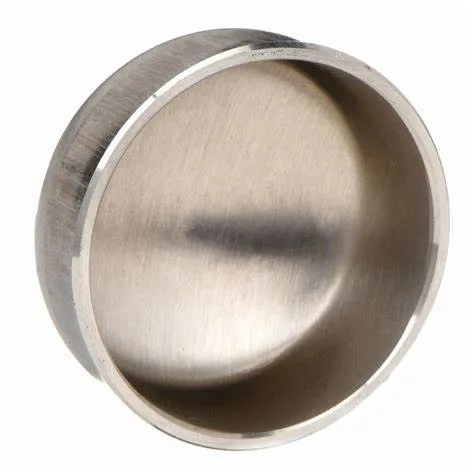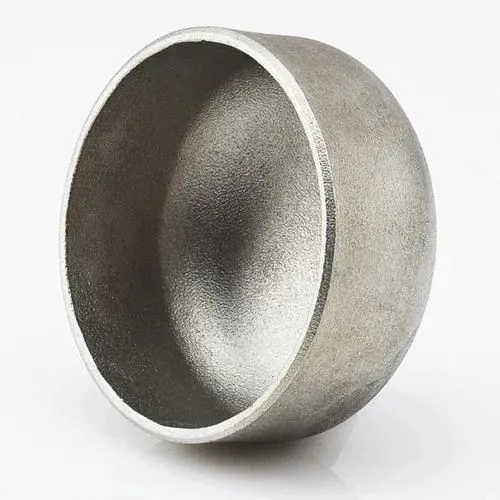JIS B2311 yog Japanese Industrial Standard uas npog pob tw-welding yeeb nkab fittings, nrog rau cov kaus mom siv hauv cov kav dej. Butt-welding caps pab lub hom phiaj ntawm kev kaw qhov kawg ntawm cov yeeb nkab, muab lub foob kom tiv thaiv kom tsis txhob muaj paug lossis paug. Nov yog ib qho kev qhia txog JIS B2311 taub qab vuam kaus mom:
- 1. JIS B2311 Standard:
- - JIS B2311 tus qauv qhia qhov yuav tsum tau ua rau kev tsim, qhov ntev, cov khoom siv, kev tsim khoom, thiab kev sim cov pob tw-welding fittings, nrog rau cov kaus mom, hauv cov kav dej.
- - Tus qauv xyuas kom meej tias cov kaus mom ua raws li JIS cov qauv ua tau raws li cov qauv zoo thiab sib xws nrog lwm cov kav dej.
- 2. Butt-welding Cap:
- - Lub taub hau-welding cap, raws li JIS B2311, yog ib qho haum tsim los npog thiab kaw qhov kawg ntawm cov yeeb nkab kom ruaj ntseg, muab kev tiv thaiv thiab tswj kev ncaj ncees ntawm cov kav dej.
- - Cov kaus mom siv rau hauv cov xwm txheej uas cov yeeb nkab kawg yuav tsum tau kaw, mus tas li lossis ib ntus, txhawm rau tiv thaiv kom tsis txhob xau, sib kis, lossis ua kom tiav rau lub kaw lus.
- 3. Khoom siv thiab kev tsim kho:
- - Lub taub hau-welding caps raws li JIS B2311 specifications muaj nyob rau hauv ntau yam ntaub ntawv xws li carbon steel, stainless hlau, thiab hlau alloy kom tau raws li cov kev cai sib txawv.
- - Cov kaus mom no yog tsim los siv cov txheej txheem tsim kho kom ntseeg tau tias muaj zog thiab tsis muaj kev sib txuas thaum welded mus rau qhov kawg ntawm cov yeeb nkab.
- 4. Daim ntawv thov thiab cov txiaj ntsig:
- - Lub kaus mom-welding pom cov ntawv thov hauv ntau qhov kev lag luam, suav nrog roj thiab roj, cov txheej txheem tshuaj, cov chaw kho dej, thiab lwm yam uas cov yeeb nkab xaus yuav tsum tau capped kom ruaj ntseg.
- - Cov kaus mom muab kev tiv thaiv rau cov yeeb nkab kawg ntawm ib puag ncig, tiv thaiv kev sib kis, thiab pab tswj kev huv thiab kev ncaj ncees ntawm cov kav dej.
- 5. Kev teeb tsa thiab vuam:
- - Kev txhim kho kom zoo, suav nrog kev sib raug zoo, kev npaj cov yeeb nkab kawg, thiab cov txheej txheem vuam, yog qhov tseem ceeb thaum txhim kho lub pob tw-welding lub kaus mom kom ntseeg tau tias muaj kev sib khi nruj thiab tsis muaj pov thawj.
- - Vuam yog ib txoj hauv kev los txuas cov kaus mom rau cov kav dej, muab kev ruaj ntseg thiab kaw ruaj khov uas tuaj yeem tiv taus siab, kub hloov pauv, thiab cov dej ntws hauv lub cev.
- Hauv cov ntsiab lus, JIS B2311 pob tw-welding lub kaus mom yog cov khoom siv tseem ceeb siv hauv cov kav dej kom kaw thiab tiv thaiv qhov kawg ntawm cov kav dej kom ruaj ntseg. Cov kaus mom no ua raws li cov qauv kev cai kom ua tau zoo, kev ntseeg tau, thiab kev sib raug zoo hauv cov ntawv thov kev lag luam uas tsim nyog yuav tsum tau kaw cov yeeb nkab thiab kev tiv thaiv.
What Is a Butt Welding Cap and How Is It Used in Industrial Piping?
In industrial piping systems, end-of-line sealing and branch closures require robust solutions. A butt welding cap serves as a critical component for terminating pipes securely. By providing a seamless, welded closure, this fitting maintains system integrity, prevents leaks, and supports compliance with industry standards.
What Is a Butt Welding Cap?
A butt welding cap—also called a pipe end cap or buttweld end cap—is a round fitting designed to close off the end of a pipe. It’s manufactured to match the pipe’s outer diameter and schedule, with either a hemispherical or flat face. To install, both the pipe end and cap are beveled to form a V‑groove, enabling full‑penetration, fusion welds. Common materials include carbon steel, stainless steel, nickel alloys, and other engineered grades, chosen to satisfy pressure, temperature, and corrosion‑resistance requirements.
How Is Butt Welding Cap Used in Industrial Piping?
Butt welding caps find application across oil & gas, petrochemical, power generation, water treatment, and general process industries for both permanent and temporary closures. During hydrostatic testing, technicians install caps to seal off sections of piping while monitoring for leaks. In new construction or retrofit projects, caps terminate branch lines, future tie‑in spools, or dead‑end mains until system expansion. Welders prepare each joint by cleaning and beveling surfaces, aligning the cap precisely, and executing a root pass followed by filler passes per the qualified Welding Procedure Specification (WPS). Post‑weld heat treatment and non‑destructive examination (NDE)—such as radiography or ultrasonic testing—verify weld integrity and compliance with ASME B16.9 and related standards. Additionally, temporary caps enable safe isolation during maintenance, allowing for segment testing and dewatering under regulatory protocols.
Benefits and Best Practices
Butt welding caps offer a smooth‑bore transition that minimizes flow disruption and stress concentration. Their full‑penetration welds deliver exceptional structural strength and leak resistance. To optimize performance, engineers should:
Select caps with matching material grades and wall thicknesses
Adhere to proper bevel angles and joint fit‑up tolerances
Follow qualified WPS protocols rigorously
Consider cladding or protective coatings in corrosive environments to extend service life
Regular inspection and thorough documentation ensure long‑term reliability and safe operation under demanding conditions.
Butt welding caps are indispensable components for achieving durable, leak‑proof pipe terminations in a wide range of industrial applications.
Butt Welding Cap FAQs
What is a butt welding cap?
|
What materials are commonly used?
|
What standards govern butt welding caps?
|
How are butt welding caps installed?
|
Where are butt welding caps typically used?
|
What are the advantages of threaded caps?
|
















